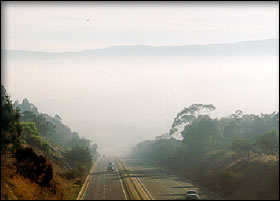 The Scientist: The Scientist:
Tim Jordan BAppSc(Hons)
School of Chemistry,
University of Tasmania
Tim grew up in Launceston where he went to Riverside High School and then Launceston College. At college, Tim’s studies included maths, computing, and geography, but it was chemistry that really “clicked”, motivating him to enrol in a Bachelor of Applied Science at the University of Tasmania and to major in chemistry.
In the third year of his degree, Tim’s interests really started to sway towards environmental chemistry, and he became involved in a project investigating industrial solvent emissions at Bell Bay on the Tamar River.
“After the Bell Bay project, I enrolled to do a fourth year of my degree, the Honours year, and got into air pollution. This is a major problem in Launceston’s air, and most of it comes from combustion sources like wood heaters and cars.”
Tim was awarded First Class Honours for his research and has now expanded his ideas into a PhD project looking at wood smoke composition.
Tim’s research involves a combination of laboratory work, field trips to collect air and sediment samples, and a fair bit of manual labour. To get started, he had to design and build a wood heater testing facility on campus! His work also involves travel opportunities, with regular trips to the Australian Nuclear Science and Technology Organisation in Sydney to measure radiocarbon levels in airborne particulate matter to determine fossil versus wood heater contributions. He has also studied a semester abroad as an exchange student in Sweden, where lectures were conducted in English just for him.
“One of the best things about my degree and my research is the way in which I can combine my personal interests – travel, the environment and wilderness – with my work,” he says.
Tim’s enthusiasm and dedication has certainly paid off. As an undergraduate student has was regularly placed on the Dean’s Roll of Excellence for outstanding achievement. In 1999 he was awarded the Royal Australian Chemical Institute 3rd Year Prize for most outstanding graduate in Chemistry at the University of Tasmania, and in 2001 was awarded the Dean’s Citation and the University Medal for outstanding academic performance in undergraduate and honours courses.
More about the work:
Key words: Air pollution, wood heaters, combustion sources
The main focus of the project is to investigate the effect of woodheaters on the wintertime air pollution in Launceston; this is been done in three parts:
- To estimate historical pollution levels by determining levels of certain pollutants in the sediments of the Tamar River.
- To obtain a “chemical fingerprint” of woodsmoke.
- To determine how much of the pollution comes from woodheaters.
Tim says “Despite the majority of my work being chemistry and laboratory based, I have had experience collecting mud samples from the Tamar River, building a woodheater testing rig, and have travelled to Lucas Heights near Sydney (yes, that is where the nuclear reactor is!) to do carbon-14 ‘dating’ on the air pollution.”
Results have shown that it is possible to tell the difference between clean-burning and smokey woodheaters by comparing their ‘fingerprints’. The carbon-14 dating showed that woodheaters contribute around 85-95% of airborne pollution during the winter. Unfortunately, the results from the historical work were inconclusive.
The project is part of the Analytical and Environmental Chemistry program at the School of Chemistry, University of Tasmania.


Websites:
Less Wood Heaters – Less Pollution in Launceston
https://www.deh.gov.au/minister/env/2003/mr19sep203.html
University of Tasmania, School of Chemistry
https://www.scieng.utas.edu.au/chem
|
